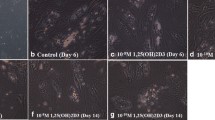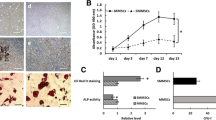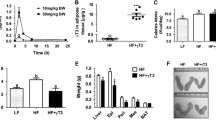Abstract
Alendronate, a bisphosphonate used to prevent osteoporosis, stimulates osteogenesis but impairs adipogenesis. Different clinical trials suggest that the incidence of diabetes may be lower in patients treated with alendronate. Taking into account the importance of adipocytes and macrophages of adipose tissue in insulin resistance and type 2 diabetes, it is necessary to evaluate the effect of alendronate in both cell types. In this paper, we investigated the effect of alendronate on the differentiation to adipocytes of 3T3-L1 fibroblasts, the cell line most used to study adipogenesis, and also its effect on lipid content and oxidative stress in mature adipocytes as well as on the inflammatory response of macrophages. We found that alendronate inhibits differentiation of 3T3-L1 fibroblasts to adipocytes in keeping with reports in other cell lines. On the other hand, treatment of 3T3-L1 adipocytes with alendronate was able to decrease triglyceride content and to prevent H2O2-induced lipid peroxidation which was evaluated as an indicator of oxidative stress. In addition, it was found that activation of RAW 264.7 macrophages to a pro-inflammatory M1 type is inhibited by this bisphosphonate. These results suggest that alendronate may contribute to prevent adipocyte excessive enlargement and the induction of oxidative stress in 3T3-L1 adipocytes as well as the activation of macrophages to a pro-inflammatory M1 type, which are events associated with adipose tissue dysfunction and insulin resistance. In this study, we unraveled the underlying mechanisms of events that were previously observed in clinical trials.






Similar content being viewed by others
References
Anastasilakis AD, Tsourdi E, Tabacco G, Naciu AM, Napoli N, Vescini F, Palermo A (2021) The impact of antiosteoporotic drugs on glucose metabolism and fracture risk in diabetes: good or bad news? J Clin Med 10(5):996. https://doi.org/10.3390/jcm10050996
Araki S, Dobashi K, Kubo K, Yamamoto Y, Asayama K, Shirahata K (2005) N-Acetylcysteine attenuates TNF alfa; induced changes in secretion of interleukin-6, plasminogen activator inhibitor-1 and adiponectin from 3T3-L1 adipocytes. Life Sci 79:2405–2412
Arner P, Bernard S, Salehpour M, Possnert G, Liebl J, Steier P, Buchholz BA, Eriksson M, Arner E, Hauner H, Skurk T, Rydén M, Frayn KN (2011) Spalding KL Dynamics of human adipose lipid turnover in health and metabolic disease. Nature 478:110–113
Black DM, Cummings SR, Karpf DB, Cauley JA, Thompson DE, Nevitt MC, Bauer DC, Genant HK, Haskell WL, Marcus R, Ott SM, Torner JC, Quandt SA, Reiss TF, Ensrud KE, Fracture Intervention Trial Research Group (1996) Randomised trial of effect of alendronate on risk of fracture in women with existing vertebral fractures. Lancet 348:1535–1541
Bradford MM (1975) A rapid and sensitive method for the quantitation of microgram quantities of protein utilizing the principle of protein-dye binding. Anal Biochem 72:248–254
Capurso C, Capurso A (2012) From excess adiposity to insulin resistance: the role of free fatty acids. Vascul Pharmacol 57:91–97. https://doi.org/10.1016/j.vph.2012.05.003
Chan DC, Yang RS, Ho CH, Tsai YS, Wang JJ, Tsai KT (2015) The use of alendronate is associated with a decreased incidence of type 2 diabetes mellitus–a population-based cohort study in Taiwan. PLoS ONE 10:e0123279. https://doi.org/10.1371/journal.pone.0123279
Ding N, Liu C, Yao L, Bai Y, Cheng P, Li Z, Luo K, Mei T, Li J, Xing J, Gao X, Ma Q, Xu J, Luo F, Dou C (2018) Alendronate induces osteoclast precursor apoptosis via peroxisomal dysfunction mediated ER stress. J Cell Physiol. https://doi.org/10.1002/jcp.26587
Duque G, Rivas D (2007) Alendronate has an anabolic effect on bone through the differentiation of mesenchymal stem cells. J Bone Miner Res 22:1603–1611
Fu L, Tang T, Miao Y, Zhang S, Qu Z, Dai K (2008) Stimulation of osteogenic differentiation and inhibition of adipogenic differentiation in bone marrow stromal cells by alendronate via ERK and JNK activation. Bone 43:40–47. https://doi.org/10.1016/j.bone.2008.03.008
Furukawa S, Fujita T, Shimabukuro M, Iwaki M, Yamada Y, Nakajima Y, Nakayama O, Makishima M, Matsuda M, Shimomura I (2004) Increased oxidative stress in obesity and its impact on metabolic syndrome. J Clin Invest 114:1752–1761
Gabrielli M, Martini CN, Brandani JN, Raiger Iustman L, Romero DG, Vila MC (2014) Exchange protein activated by cyclic AMP is involved in the regulation of adipogenic genes during 3T3-L1 fibroblasts differentiation. Develop Growth Differ 56:143–151. https://doi.org/10.1111/dgd.12114
Gabrielli M, Romero DG, Martini CN, Raiger Iustman LJ, Vila MDC (2018) MCAM knockdown impairs PPARγ expression and 3T3-L1 fibroblasts differentiation to adipocytes. Mol Cell Biochem 448(1–2):299–309. https://doi.org/10.1007/s11010-018-3334-8
Gao M, Zhao Z, Lv P, Li Y, Gao J, Zhang M, Zhao B (2015) Quantitative combination of natural anti-oxidants prevents metabolic syndrome by reducing oxidative stress. Redox Biol 6:206–217. https://doi.org/10.1016/j.redox.2015.06.013
Guo H, Ling W, Wang Q, Liu C, Hu Y, Xia M (2008) Cyanidin 3-glucoside protects 3T3-L1 adipocytes against H2O2-or TNF-alpha-induced insulin resistance by inhibiting c-Jun NH2-terminal kinase activation. Biochem Pharmacol 75:1393–1401. https://doi.org/10.1016/j.bcp.2007.11.016
Hermes-Lima M, Willmore WG, Storey KB (1995) Quantification of lipid peroxidation in tissue extracts based on Fe(III) xylenol orange complex formation. Free Radic Biol Med 19:271–280
Karimi Fard M, Aminorroaya A, Kachuei A, Salamat MR, Hadi Alijanvand M, Aminorroaya Yamini S, Karimifar M, Feizi A, Amini M (2019) Alendronate improves fasting plasma glucose and insulin sensitivity, and decreases insulin resistance in prediabetic osteopenic postmenopausal women: a randomized triple-blind clinical trial. J Diabetes Investig 10(3):731–737. https://doi.org/10.1111/jdi.12944
Korbecki J, Bajdak-Rusinek K (2019) The effect of palmitic acid on inflammatory response in macrophages: an overview of molecular mechanisms. Inflamm Res 68:915–932
Lumeng CN, Bodzin JL, Saltiel AR (2007) Obesity induces a phenotypic switch in adipose tissue macrophage polarization. J Clin lnvest 117:175–184
Marquez MP, Alencastro F, Madrigal A, Jimenez JL, Blanco G, Gureghian A, Keagy L, Lee C, Liu R, Tan L, Deignan K, Armstrong B, Zhao Y (2017) The role of cellular proliferation in adipogenic differentiation of human adipose tissue-derived mesenchymal stem cells. Stem Cells Dev 26:1578–1595. https://doi.org/10.1089/scd.2017.0071
Martini CN, Plaza MV, Vila MC (2009) PKA-dependent and independent signaling in 3T3-L1 fibroblasts differentiation. Mol Cell Endocrinol 298:42–47
Martini CN, Gabrielli M, Brandani JN, Vila MC (2016) Glyphosate inhibits PPAR γ induction and differentiation of preadipocytes and is able to induce oxidative stress. J Biochem Mol Toxicol 30:404–413. https://doi.org/10.1002/jbt.21804
Martins CA, Leyhausen G, Volk J, Geurtsen W (2015) Effects of alendronate on osteoclast formation and activity in vitro. J Endod 41:45–49. https://doi.org/10.1016/j.joen.2014.07.010
Maslov LN, Naryzhnaya NV, Boshchenko AA, Popov SV, Ivanov VV, Oeltgen PR (2018) Is oxidative stress of adipocytes a cause or a consequence of the metabolic syndrome? J Clin Transl Endocrinol 15:1–5. https://doi.org/10.1016/j.jcte.2018.11.001
Mohamed MT, Abuelezz SA, Atalla SS, El Aziz LFA, Gorge SS (2017) The anti-osteoporotic and anti-atherogenic effects of alendronate and simvastatin in ovariectomized rats fed high fat diet: a comparative study of combination therapy versus monotherapy. Biomed Pharmacother 89:1115–1124
Moreno-Fernández S, Garcés-Rimón M, Veram G, Astier J, Landrier JF, Miguel M (2018) High fat/high glucose diet induces metabolic syndrome in an experimental rat model. Nutrients 10, 1502. https://doi.org/10.3390/nu10101502.
Pacienza N, Lee RH, Bae EH, Kim DK, Liu Q, Prockop DJ, Yannarelli G (2018) In vitro macrophageassay predicts the in vivo antiinflammatory potential of exosoms from human mesenchymal stromal cells. Mol Ther Methods Clin Dev 13:67–76. https://doi.org/10.1016/j.omtm.2018.12.003
Park S, Park NY, Valacchi G, Lim Y (2012) Calorie restriction with a high-fat diet effectively attenuated inflammatory response and oxidative stress-related markers in obese tissues of the high diet fed rats. Mediators Inflamm 2012:984643. https://doi.org/10.1155/2012/984643
Parwin A, Najmi AK, Ismail MV, Kaundal M, Akhtar M (2019) Protective effects of alendronate in Triton X-100-induced hyperlipidemia in rats. Turk J Gastroenterol 30:557–564. https://doi.org/10.5152/tjg.2019.18076
Petersen RK, Madsen L, Pedersen LM, Hallenborg P, Hagland H, Viste K, Doskeland SO, Kristiansen K (2008) Cyclic AMP (cAMP)-mediated stimulation of adipocyte differentiation requires the synergistic action of EPAC- and cyclic AMP-dependent protein kinase-dependent processes. Mol Cell Biol 28:3804–3816
Ramírez-Zacarías JL, Castro-Muñozledo F, Kuri-Harcuch W (1992) Quantitation of adipose conversion and triglycerides by staining intracytoplasmic lipids with Oil Red O. Histochemistry 97:493–497
Rosen ED, Spiegelman BM (2014) What we talk about when we talk about fat. Cell 156:20–44. https://doi.org/10.1016/j.cell.2013.12.012
Rydén M, Andersson DP, Bernard S, Spalding K, Arner P (2013) Adipocyte triglyceride turnover and lipolysis in lean and overweight subjects. J Lipid Res 54:2909–2913
Sanderson J, Martyn-St James M, Stevens J, Goka E, Wong R, Campbell F, Selby P, Gittoes N, Davis S (2016) Clinical effectiveness of bisphosphonates for the prevention of fragility fractures: a systematic review and network meta-analysis. Bone 89:52–58. https://doi.org/10.1016/j.bone.2016.05.013
Schindelin J, Arganda-Carreras I, Frise E, Kaynig V, Longair M, Pietzsch T, Preibisch S, Rueden C, Saalfeld S, Schmid B, Tinevez JY, White DJ, Hartenstein V, Eliceiri K, Tomancak P, Cardona A (2012) Fiji: an open-source platform for biological-image analysis. Nat Methods 9:676–682. https://doi.org/10.1038/nmeth.2019
Schwartz AV, Schafer AL, Grey A, Vittinghoff E, Palermo L, Lui LY, Wallace RB, Cummings SR, Black DM, Bauer DC, Reid IR (2013) Effects of antiresorptive therapies on glucose metabolism: results from the FIT, HORIZON-PFT, and FREEDOM trials. J Bone Miner Res 28(6):1348–1354. https://doi.org/10.1002/jbmr.1865
Seidell JC, Halberstadt J (2015) The global burden of obesity and the challenges of prevention. Ann Nutr Metabol 66:7–12. https://doi.org/10.1159/000375143
Subauste AR, Burant CF (2007) Role of FoxO1 in FFA-induced oxidative stress in adipocytes. Am J Physiol Endocrinol Metab 293:E159–E164. https://doi.org/10.1152/ajpendo.00629.2006
Tatsumi F, Kaneto H, Hashiramoto M, Tawaramoto K, Obata A, Kimura T, Shimoda M, Hamamoto S, Kanda-Kimura Y, Kamei S, Mune T, Matsuda M, Kaku K (2015) Anti-hypertensive azelnidipine preserves insulin signaling and glucose uptake against oxidative stress in 3T3-L1 adipocytes. Endocr J 62:741–747. https://doi.org/10.1507/endocrj.EJ15-0273
Tella SH, Gallagher JC (2014) Prevention and treatment of postmenopausal osteoporosis. J Steroid Biochem Mol Biol 142:155–170. https://doi.org/10.1016/j.jsbmb.2013.09.008
Toulis KA, Nirantharakumar K, Ryan R, Marshall T, Hemming K (2015) Bisphosphonates and glucose homeostasis: a population-based, retrospective cohort study. J Clin Endocrinol Metab 100(5):1933–1940. https://doi.org/10.1210/jc.2014-3481
Vestergaard P (2011) Risk of newly diagnosed type 2 diabetes is reduced in users of alendronate. Calcif Tissue Int 89:265–270. https://doi.org/10.1007/s00223-011-9515-z
Vieira-Potter VJ (2014) Inflammation and macrophage modulation in adipose tissues. Cell Microbiol 16:1484–1492. https://doi.org/10.1111/cmi.12336
Walsh ME, Shi Y, Van Remmen H (2014) The effects of dietary restriction on oxidative stress in rodents. Free Radic Biol Med 66:88–99. https://doi.org/10.1016/j.freeradbiomed.2013.05.037
Wang PP, She MH, He PP, Chen WJ, Laudon M, Xu XX, Yin WD (2013) Piromelatine decreases triglyceride accumulation in insulin resistant 3T3-L1 adipocytes: role of ATGL and HSL. Biochimie 95:1650–1654. https://doi.org/10.1016/j.biochi.2013.05.005
World Health Organization. Obesity and overweight. 2018. https://www.who.int/news-room/fact-sheets/detail/obesity-and-overweight
Funding
This work was supported by research grants PIP 11220130100768 (to M.V.) and PIP 11220150100188CO (to GY) from Consejo Nacional de Investigaciones Científicas y Técnicas of Argentina. The funders had no role in the study design, data and analysis, decision to publish, or preparation of the manuscript.
Author information
Authors and Affiliations
Contributions
The authors declare that all data were generated in-house and that no paper mill was used.
Corresponding author
Ethics declarations
Conflict of interest
The authors declare no competing interests.
Additional information
Publisher's note
Springer Nature remains neutral with regard to jurisdictional claims in published maps and institutional affiliations.
Key Points
•Alendronate inhibits 3T3-L1 fibroblasts differentiation to adipocytes.
• Alendronate could decrease adipocyte lipid content and prevent excessive enlargement.
• Alendronate diminishes H2O2-induced increase in oxidative stress in 3T3-L1 adipocytes.
• Alendronate prevents polarization to a pro-inflammatory M1-type macrophage.
Rights and permissions
About this article
Cite this article
Martini, C., Sosa, F.N., Malvicini, R. et al. Alendronate inhibits triglyceride accumulation and oxidative stress in adipocytes and the inflammatory response of macrophages which are associated with adipose tissue dysfunction. J Physiol Biochem 77, 601–611 (2021). https://doi.org/10.1007/s13105-021-00826-9
Received:
Accepted:
Published:
Issue Date:
DOI: https://doi.org/10.1007/s13105-021-00826-9




